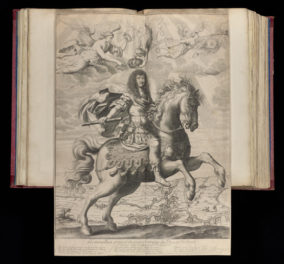After several months of writing and archival processing, I’ve just finished my work on the archive of Galerie Schmela. The archive’s 172 boxes and 25 flat file folders are listed and described here.
The records of Galerie Schmela in Düsseldorf document the business of the German art dealer Alfred Schmela (1918–1980) from his inaugural show in 1957 until his death in 1980, as well as the continuation of the gallery by Schmela’s wife and daughter during the 1990s.
Alfred Schmela passionately sought out and promoted new and self-conscious artists emerging in the changing social, political, and cultural landscapes of postwar Europe and United States. “Go to Galerie Schmela” was the insider tip for those in the young European and American art scene. Schmela was one of the first in Germany to exhibit the “new” Americans Gordon Matta-Clark and Bruce Nauman. Arman, Robert Indiana, Robert Morris, Kenneth Noland, Richard Tuttle also exhibited at Galerie Schmela.
The artists shown by Schmela represented various and often overlapping tendencies such as Monochrome, Kinetic Art, Performance or Happenings, Nouveau Réalisme, Spatialism, Auto-Destructive art, and a general fascination with perception and technology. Schmela played a pivotal role in the development of ZERO, a group of artists formed in the mid-1950s by Heinz Mack, Otto Piene, and Günther Uecker in opposition to Art Informel. He also was a personal friend of German performance artist and influential art theorist Joseph Beuys and a committed advocate of his art.
It was at Galerie Schmela where, on November 26, 1965, Beuys covered his head with gold leaf and honey and walked around with a dead hare cradled in his arms, whispering to the dead animal about the surrounding art. This famous action, known as How to Explain Pictures to a Dead Hare, is regarded as the culmination of Beuys’s influential and controversial teachings on art, known as the “extended definition of art.”

Me with documents from the Galerie Schmela archive in the Special Collections Reading Room at the Research Library, Getty Research Institute
Another pivotal event organized by Galerie Schmela was the mourning over the third and last issue of ZERO the magazine—which was also the celebration and inauguration of ZERO the art group. This action was called “Edition-Exposition-Demonstration” and took place on July 5, 1961, in the street in front of the gallery and inside.
Galerie Schmela was also the place where, in 1957, Yves Klein exhibited his blue monochromatic canvases in his first solo show in Germany. Otto Piene’s series of light paintings, Light Ballet, were first shown at Galerie Schmela in 1959, as were Arman’s dustbins in 1960.
Other artists who had their first solo show, or first solo show in Germany, at Galerie Schmela are Lucio Fontana, Sam Francis, Jörg Immendorff, Konrad Klapheck, Morris Louis, Georges Mathieu, Gordon Matta-Clark, Robert Morris, Kenneth Noland, Martial Raysse, George Segal, Antoni Tàpies, Jean Tinguely, Günther Uecker—and many others.
The Schmela archive at the Getty Research Institute contains hundreds of rare vintage photographs of performances, exhibitions, and artwork central to the development of art in Europe and United States after World War II.
Rich in detail regarding individual artwork and exhibition activities is Schmela’s correspondence with artists such as Shusaku Arakawa, Joseph Beuys, Christo, Lucio Fontana, Michael Gitlin, Robert Indiana, Christian Löwenstein, Georges Mathieu, Robert Morris, Walter Pichler, Otto Piene, Yvonne Rainer, Raphael Jesús Soto, and Richard Tuttle…just to name a few.
Extensive correspondence with collectors, art dealers, museum curators, and art critics is also part of the archive. It reveals the instrumental role Schmela played in shaping the art market by introducing and promoting innovative and challenging contemporary art.
Also in the archive is a sizeable collection of small exhibition catalogs, invitations, and posters on a vast number of artists, European and American, and an impressive collection of exhibition reviews and other articles on contemporary art and artists dating from the late 1950s to the late 1990s, clipped from German press, predominantly from the Rhine Region.
Galerie Schmela records are now open for use by researchers at the Research Library. I look forward to what new stories about postwar art they will help us tell.

See all posts in this series »




Fascinating information, seeing the link that Alfred Schelma’s Galerie had to so many artists and the movements that they were linked to. I enjoyed finding out about How to Explain Art to a Dead Hare. I enjoyed reading this blog and learning more about the artists of that time.
I am not sure if you are the person to communicate with. The first week of September I will be in los Angeles and I would like to work in the Schmela archive. I have made a list with documents and photos I would like to see or hear. I am director ZERO foundation, and therefore interested in all artist related to the German group ZERO.
If you are not the person to talk with, can you please be so friendly to forward my mail or let me know who I should contact?
Best Regards,
Tijs Visser
Director
ZERO foundation
Zollhof 11
D-40221 Düsseldorf
Phone 0049 (0)211 59805978
IPhone 0049 (0)173 7312750
I had a one person show at Galerie Schmela in 1976. Although nothing was sold some work was not returned at the close of the show. I am trying to locate some of the works I exhibited in Europe in the seventies for my personal archives. I don’t wish to recover them but merely to see if they still exist.
Can you inform me if any of my work(s) are in the Schmela Archives. I would very much appreciate it.